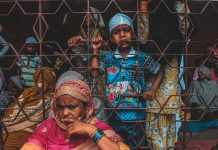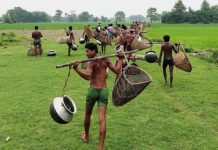
There has been a growing demand from some economists and several activists that as the government’s granaries are overstocked with food grain ( wheat and rice ) stocks much beyond the essential norms, a significant part of the surplus grain ( understood as grain stocks beyond the normal storage norms) should be distributed more or less free among hunger-affected people , and/or else should be used to universalize the food security/ public distribution system. This a well-reasoned demand, as too much of excess storage leads to increase in storage costs as well as increased chances of stored foodgrain getting spoiled . Also there is clear evidence in recent times of increased possibilities of hunger due to loss of livelihoods and breakdown of coping mechanisms of people ( such as migrant labor), as well as reduced food availability in leading nutrition schemes like ICDS ( anganwadi) and mid-day meals.
Beyond this, however, there is need for further analysis of various aspects of this phenomenon of ‘Empty Stomachs and Packed Godowns’. This was the title also of my book on aspects of India’s food system published in 1987. Clearly these peculiar conditions of overstuffed granaries existing side-by-side with widespread hunger have existed for several decades with some ups and downs. Several aspects of this phenomenon need to be examined carefully.
This is sometimes interpreted as an obvious manifestation of production of surplus food. However it is obvious also that a large number of people are unable to eat enough to satisfy the pangs of hunger. Will a surplus exist, in excess of normal storage norms, if all people are eating as per their actual food needs? Due to prevailing high levels of poverty and inequalities a large number of people do not have the capacity to purchase adequate food grain and this may result in appearance of surplus food grain, at least surplus cereals.
This is likely to be much more obvious if we do not consider just the two main cereals ( rice and wheat) but all the main ingredients of a nutritionally balanced diet. Then it becomes obvious that in terms of the nutrition needs of people India may be actually deficient in important staple nutrition foods like pulses, vegetables and fruits. Also one reason why production of wheat and rice appears to be surplus is that this has often taken place at the cost of nutritionally rich crops like millets and pulses.
Another important aspect is that production of important foods grows but its use-patterns is such as to increase consumption among the rich and decrease consumption among the poor. This is particularly visible in the case of milk and milk products. Milk consumption among the poor shows a declining trend in many villages and slums. The consumption of chaach, the residue drink obtained after the village-level production of butter and ghee, is a good protein drink which used to be available free to the poor as well till some years back. At the same time there has been a big increase in the production of ice cream, butter, ghee, milk-based sweets and cheese for the richer consumers.
In addition there is the increasing diversion of food crops to various industries. Many healthy foods including grain and fruits are increasingly diverted on a huge scale to the production of liquor. There is increasing talk of diverting more grain for production of bio-fuels and sanitizers.
Combining all this, the overall trend is of food production being diverted increasingly from its primary purpose and focus of preventing hunger and malnutrition.
The poorest rural people had more direct access to food crops earlier. The best protection against hunger in a village is to have some farmland. For over three decades after independence land reforms based mainly on land distribution among the poor were very much on the agenda. The progress was very slow but this was at least accepted as an important means of reducing hunger and poverty. Now this is entirely gone from the government agenda. The local landless are no longer candidates for giving of land by the government; corporate are.
In the 2001 census a total of 127 million farmers were identified; their number had reduced to 118 million in 2011. The number of artisans also declined. The number of landless workers grew in even larger numbers so that in 2011 for the first time the number of farm workers was found to be higher than the number of farmers. Thus food harvests were being taken home by a steadily decreasing number of rural households. While several farmers grew at least adequate grains for self-consumption, they were increasingly indebted and so had to hand over a significant part of their crop to moneylenders.
While the number of farm workers was increasing, indiscriminate mechanization was introduced even in those operations which were most crucial for the food security of landless farm workers. Crop harvesting work used to be the main work in which farm workers had more bargaining capacity as crops had to be harvested in time. Hence this was the time when they ( including women workers) earned the most. In many parts of the country harvesting wages were paid as part of the harvested crop. Hence farm workers could store food crops for a few months. But with the increasing mechanization of harvesting work in recent times this employment has been denied to many workers, and this is a fast rising trend.
Food-for-work programs also directly provided food to landless farm workers, but these were stopped after some time. Drought-relief also more or less stopped after the introduction of MGNREGA, so that MGNREGA more or less became the only hope for the poor. But with less than adequate budgets, rampant corruption and delayed wages, could this make up for all the other losses? Hence dependence on migrant labor as a coping mechanism went on increasing despite all the hardships till recently until this too collapsed suddenly.
Hence there is certainly a case for more allocations of food from the overstocked granaries for helping to reduce the hunger faced by millions of poor people, but this should be seen as only a temporary solution. More basic reform for reducing and ending hunger on a sustainable basis should be along the lines of reducing inequalities, reintroducing land redistribution program for the poor and providing a firm base to the livelihoods of weaker sections.
Bharat Dogra is a freelance journalist who has been involved with several social movements.













